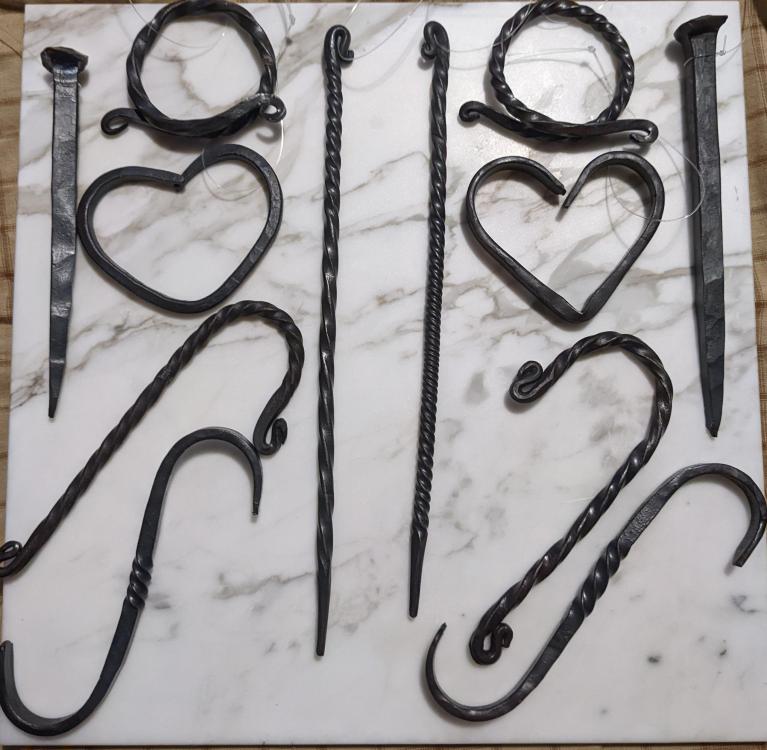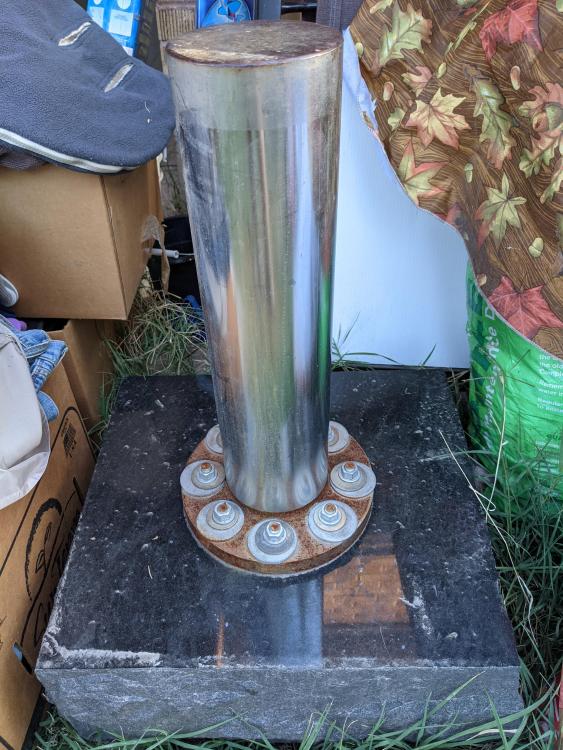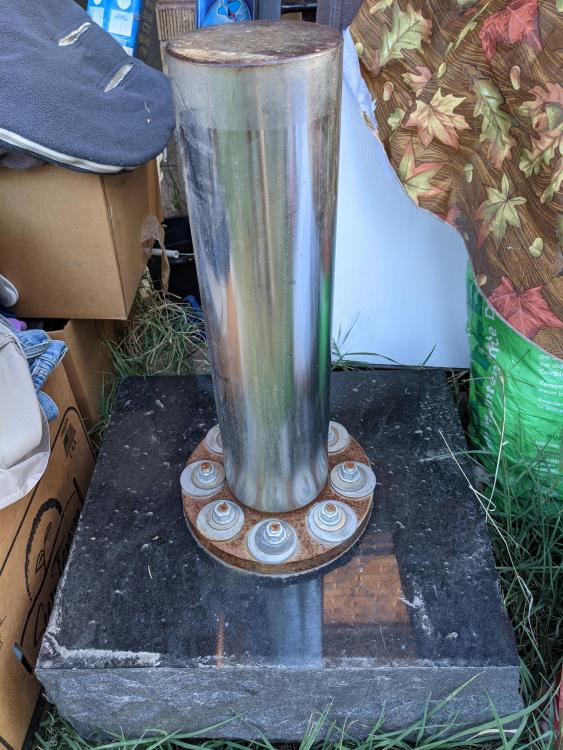-
Posts
370 -
Joined
-
Last visited
Content Type
Profiles
Forums
Articles
Gallery
Downloads
Events
Posts posted by FlatLiner
-
-
13 hours ago, Patrick Kelly said:
Thank you for the feedback and advice. I'm going to ditch my original plan and settle for something more traditional and safer. I've found some really cool ideas for a proper stand just browsing this site.
Seasons greetings all

Seasons Greetings. At first some on this site can come across pretty abrasively but they really do have the best interest in mind and there are literally hundreds of combined years experience here.
-
I wish I could see a pic of his anvil to compare to my beat up Sisco(Söderfors) anvil.
-
Your welcome. I just happen to have a 135 lb Columbian. It took awhile to find out what little info I have on them. Yours looks to be in great shape. Mine had one edge chipped up from cold horseshoeing. I'd love to have a 300 pounder but it is out of my price range right now with the current anvil prices.
-
In your last pic I see the two horizontal part lines. One at the top of the waist and one at the bottom of the waist. The inverted Triangle and overall look to me screams Columbian. Columbian anvils are top tier anvils.
-
My Columbian lacks handling holes and the part lines run horizontal not vertical.
-
Columbian anvils as far as I could find don't have serial numbers and very few identifying marks.
Manufactured by Columbian hardware Company,
The Columbian Hardware Co. was located in Cleveland OH and made blacksmiths anvils from about 1905 to 1925. After that they distributed a Swedish made version of their anvil for about 2 years. Columbian anvils were a top quality cast steel anvil with a machined and heat treated face.
Columbian marked their anvils with the C inside an upside down recessed triangle. They advertised that the base was always the same width as the anvil height for stability.
-
I used to use logs but I got tired of chaising them around and built metal tripod stands. In my limited experience they seem to be more stable and the anvils respond better.
-
-
I have three improvised anvils. You can find them in the improvised anvil section. I use them just as much as my "real" anvils. One is a 5" x 19" cylinder made out of S5. One is made from two 2" x 8" forklift tines welded back to back to make a 4" x 8" x 25" post anvil. I use these when I have a striker. I also have a block anvil that is made out of S7 that is 5" X 5" x 7". I paid less then $100 US dollars for all of them together. They work just as well as my London/American style anvils.
-
Nice work.
-
That's a better anvil them what most people start out with.
-
Truth be told most people don't need an anvil over 200lbs. I don't know of anyone still using a gang of strikers to forge. As Thomas said we (more so in the USA) tend to get anvil envy and want the "biggest and best" 400lb beast of an anvil when we truthfully can get by with a block of steel or a 135lb-200lb anvil.
-
JulianB, That is an awesome anvil family.
-
Those edges have been nicely rounded Iron Dragon. I wouldn't of touched it either.
-
Both of my main anvils were used for cold horseshoing so the edged were really chipped up so I had to grind them. If you Google Söderfors Paragon Anvil you will see a swedish Söderfors with the edges heavily radiused, fire Creek forge on you tube uses an anvil with heavily radiused edges, his anvil was also used for coldshoeing horses at one point in it's life. You usually don't need sharp edges on an anvil but you can always make an anvil block to fit in the Hardy with different radiused edges if you decide to grind or not to grind the edges of your anvil.
-
The overall shape, grinds on the inside of the curves above the feet but not under the tail, and the "fake" forge welded on face are the exact same as my Columbian. You can look up the specs for size and weight on Columbian anvils and check them against yours. To me it has the look of a cast steel anvil not a cast iron or wrought iron anvil. but as others have said if it passes the ring test and ball bearing test then run with it. If it is a Columbian remember they were only made for about 20 years so they are relatively more uncommon then other brands and Columbians are top tier anvils, they are extreamly hard so they have the tendency like the Swedish anvils to chip along the edges.
-
To me it look is reminiscent of Columbian anvils, but I don't know if they cast anvils for other companies or brands.
-
WOW that pattern. That is amazing. Great work.
-
Roughly 400 lb black granite block under my post anvil makes the whole thing over 500 lbs. It's bolted together using 1/2" concrete anchors drilled into the stone. I did it this way so I could separate the anvil from it's base because otherwise its a beast to move. This deadened the ring and the anvil feels more solid and lively. This is my go to anvil when I am using a striker.
-
Me being a stone mason by trade. One thing I like about that video is how he is using alot of old school techniques that alot of younger people don't know about (at least here in the USA), with the advent of technology alot of these old techniques are being lost. For example, It's just easier to use an impact drill to drill your holes. But he showed various other methods for drilling depending on the situation and what he needed the hole for.
-
I have my post anvil mounted to a roughly 400 lb block of black granite. It is extremely quiet and very solid. This is my go to anvil when I am using a striker. Between the anvil and base it is over 500 lbs. It is bolted together with 1/2" concrete anchors that have been drilled into the granite. pardon the stuff around it, we are in the process of cleaning the garage out so boxes and stuff got stacked around it.
-
I've never seen a Columbian anvil in that style. I love my Columbian. I prefer the solid cast tool steel anvils over the wrought iron anvils. I feel like I move more metal with a smaller lighter anvil.
-
I found three HVAC blowers 500 cfm for $20 in my local online adds. They are quieter then a shop vac and if I burn one up I have spares.
-
Beautiful anvil. I am jealous. You have an awesome anvil collection.





Just got this last night
in Anvil Reviews by brand
Posted
Use a wire cup wheel on a 4" grinder to knock the heavy rust off but not a knoted wire cup wheel they tend to take more then rust off then use boiled linseed oil.